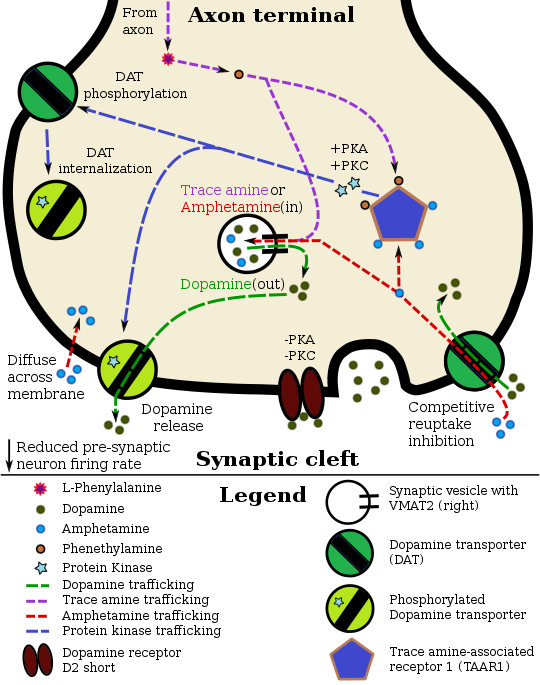Wikipedia:Featured picture candidates/TAAR1-Dopamine neuron 2
Appearance
Voting period is over. Please don't add any new votes. Voting period ends on 31 Aug 2014 at 20:44:59 (UTC)

References
- ^ a b c d Miller GM (January 2011). "The emerging role of trace amine-associated receptor 1 in the functional regulation of monoamine transporters and dopaminergic activity". J. Neurochem. 116 (2): 164–176. doi:10.1111/j.1471-4159.2010.07109.x. PMC 3005101. PMID 21073468.
- ^ a b Eiden LE, Weihe E (January 2011). "VMAT2: a dynamic regulator of brain monoaminergic neuronal function interacting with drugs of abuse". Ann. N. Y. Acad. Sci. 1216: 86–98. doi:10.1111/j.1749-6632.2010.05906.x. PMID 21272013.
VMAT2 is the CNS vesicular transporter for not only the biogenic amines DA, NE, EPI, 5-HT, and HIS, but likely also for the trace amines TYR, PEA, and thyronamine (THYR) ... [Trace aminergic] neurons in mammalian CNS would be identifiable as neurons expressing VMAT2 for storage, and the biosynthetic enzyme aromatic amino acid decarboxylase (AADC).
- ^ Offermanns S, Rosenthal W (2008). Encyclopedia of Molecular Pharmacology (2nd ed.). Berlin: Springer. pp. 1219–1222. ISBN 3540389164.
- Reason
- It's a helpful visual aid for explaining a technical concept – the pharmacodynamics of amphetamine and trace amines in dopamine neurons that contain trace amine-associated receptor 1.
- Articles in which this image appears
- Amphetamine, Adderall, Dextroamphetamine, Phenethylamine, TAAR1, Dopamine, Lisdexamfetamine, and Autoreceptor (+3 more on the German wiki
 )
) - FP category for this image
- Wikipedia:Featured pictures/Diagrams, drawings, and maps/Diagrams
- Creator
- Seppi333
- Support as nominator – Seppi333 (Insert 2¢ | Maintained) 20:44, 21 August 2014 (UTC)
- @Mattximus: Hi Mattximus; I'm pinging you since I'm finally renominating this diagram.
Note: similar to my other nominated diagram for ΔFosB, this image is transcluded into articles via template:amphetamine pharmacodynamics, although it only contains a single wikitext annotation. Seppi333 (Insert 2¢ | Maintained) 20:44, 21 August 2014 (UTC) - Weak oppose Good diagram, but needs "prettying up": The outer edge of it isn't very smooth or symmetrical (and I don't see any reason not to make it fairly symmetrical), for example; "DAT internalization" is unclear as to what it refers to due to positioning, and the colours are a bit too... bold; the mustard yellow, for example. A little shading would make it look better - the solid colouurs give it a slightly MSPaint-y feel. It's a quite good diagram, it's just not quite at FP yet. Adam Cuerden (talk) 17:34, 22 August 2014 (UTC)
- I'll see if I can tone down the boldness of the colors over the next few days. I may withdrawal this nomination since I'm not that good at manipulating the finer details in SVG diagrams though. Seppi333 (Insert 2¢ | Maintained) 04:57, 26 August 2014 (UTC)
- comment is TAAR1 membrane bound? I know it can form a heterodymer with D2R which is definitely membrane bound... Mattximus (talk) 14:07, 24 August 2014 (UTC)
- It's seldom, if at all, expressed along the membrane. PMID 18524885 Seppi333 (Insert 2¢ | Maintained) 04:57, 26 August 2014 (UTC)
Not Promoted --Armbrust The Homunculus 20:45, 31 August 2014 (UTC)
